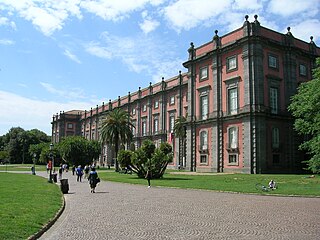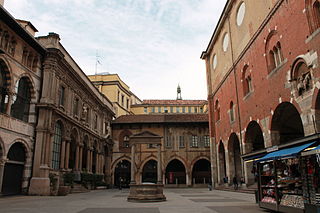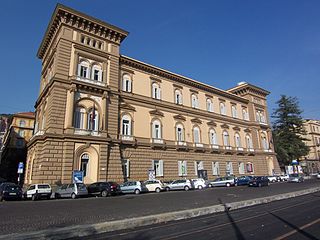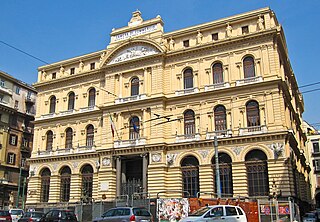
Caserta is the capital of the province of Caserta in the Campania region of Italy. An important agricultural, commercial, and industrial comune and city, Caserta is located 36 Kilometers north of Naples on the edge of the Campanian plain at the foot of the Campanian Subapennine mountain range. The city is best known for the 18th-century Bourbon Royal Palace of Caserta.

Piazza del Plebiscito is a large public square in central Naples, Italy.

Ferdinando Fuga was an Italian architect who was born in Florence, and is known for his work in Rome and Naples. Much of his early work was in Rome, notably, the Palazzo della Consulta (1732–7) at the Quirinal, the Palazzo Corsini (1736–54), the façade of the Santa Maria Maggiore (1741–3), and the Church of Sant'Apollinare (1742–8). He later moved to Naples and notably designed the Albergo de'Poveri (1751–81), the façade of the Church of the Gerolamini, and that of the Palazzo Giordano.

Spaccanapoli is the straight and narrow main street that traverses the old, historic center of the city of Naples, Italy. The name is a popular usage and means, literally, "Naples splitter". The name is derived from the fact that it is very long and from above it seems to divide that part of the city.

Palazzo Serra di Cassano is an aristocratic palace in Naples, Italy, built for the wealthy Serra family, one of the original 54 families of the 'old nobility' of Genoa, whose family was organized within an Albergo. The family insignia (crest) is frescoed on the ceiling of the Palazzo Serra's Great Hall. The family had economic interests in banking, insurance and law.

The Royal Palace of Capodimonte is a large palazzo in Naples, Italy. It was formerly the summer residence and hunting lodge of the Bourbon kings of the Two Sicilies, one of the two royal palaces in Naples. Today, it comprises the National Museum of Capodimonte and the Royal Forest. The palace was constructed on its somewhat cooler hilltop location just outside the city, with urban Naples ultimately expanding around it.

Villas and palaces in Milan are used to indicate public and private buildings in Milan of particular artistic and architectural value. Milan has always been an important centre with regard to the construction of historical villas and palaces, ranging from the Romanesque to the neo-Gothic, from Baroque to Rococo.

Piazza Mercanti is a central city square of Milan, Italy. It is located between Piazza del Duomo, which marks the centre of the modern city of Milan, and Piazza Cordusio, and it used to be the heart of the city in the Middle Ages. At the time, the square was larger than it is now and known as "Piazza del Broletto", after the "Broletto Nuovo", the palace that occupied the centre of the square. In the 13th century, there were six entry points to the square, each associated to a specific trade, from sword blacksmiths to hat makers.

Piazza della Scala is a pedestrian central square of Milan, Italy, connected to the main square of Milan, Piazza del Duomo, by the Galleria Vittorio Emanuele II passage. It is named after the renowned Teatro alla Scala opera house, which occupies the north-western side of the square; the building actually includes both the opera house and the Museo Teatrale alla Scala, dedicated to the history of La Scala and opera in general. On the opposite side to "La Scala", to the south-east, is the facade of Palazzo Marino, Milan's city hall. Another relevant building on the square, on the north-eastern side, is the Palazzo della Banca Commerciale Italiana. The south-western side of the square has the entry to the Galleria Vittorio Emanuele as well as Palazzo Beltrami. Most of the architecture of the square is due to architect Luca Beltrami, who designed the eponymous palace, the facade of Palazzo Marino, and the Banca Commerciale Italiana building. The centre of the square is marked by the monument of Leonardo da Vinci by sculptor Pietro Magni (1872).


The Fountain of Neptune is a monumental fountain, located in Municipio square, in Naples, Italy. The fountain until the end of 2014 was located across the street of via Medina across from the church of Santa Maria Incoronata, Naples and a few doors south of the church complex of Pieta di Turchini. Now the fountain is located in front of the Town hill building, its location changed due to the construction of the new underground station.

The Palazzo Orsini di Gravina is a Renaissance-style palace on number 3 Via Monteoliveto, in the San Lorenzo quarter of Rione San Giuseppe-Carità, of central Naples, Italy. Since 1940, it has housed the Faculty of Architecture of the University of Naples. It is located across the street and a few doors north of the sleek and modern Palazzo delle Poste. Across the street at the north end of the palace, is the Piazza Monteoliveto with its Fountain and the church of Sant'Anna dei Lombardi.

The Palazzo Caravita di Sirignano is a monumental palace located at via Rione Sirignano 4, corner with along the strada Riviera di Chiaia in Naples, Italy.

The Palazzo Carafa della Spina is a historic palace located on Via Benedetto Croce number 45, in the quartiere San Giuseppe of Naples, Italy. It is located between the Piazza of the Gesu Nuovo and the Piazza of San Domenico Maggiore. The Palace once belonged to a branch of the Carafa family.

The Palazzo Partanna, also once known as Palazzo Coscia, is a monumental palace located on Piazza dei Martiri 64-66 on the western edge of the neighborhood of Chiaia in Naples, Italy. The palace faces the Piazza dei Martiri.
The stile Umbertino is a 19th-century style of Renaissance Revival architecture in Italy, typical of the eclecticism of late 19th century architecture and decorative arts in Europe which mixes decorative elements from various historical styles.

The Palazzo della Borsa is a monumental 19th-century palace located in the Piazza of the same name in Naples, region of Campania, Italy. The building, built in an academic and elaborate Neo-renaissance style formerly housed the local stock exchange (Bourse), but now home to the Neapolitan Chamber of Commerce.

Borgo Nuovo, originally known as via Alessandrina, also named via Recta or via Pontificum, was a road in the city of Rome, Italy, important for historical and architectural reasons. Built by Pope Alexander VI Borgia for the holy year of 1500, the road became one of the main centers of the high Renaissance in Rome. Borgo Nuovo was demolished together with the surrounding quarter in 1936–37 due to the construction of Via della Conciliazione.

Borgo Vecchio, also named in the Middle Ages Via Sancta, Carriera Sancta or Carriera Martyrum, was a road in the city of Rome, Italy, important for historical and architectural reasons. The road was destroyed together with the adjacent quartier in 1936–37 due to the construction of Via della Conciliazione.

Piazza Scossacavalli, also named Piazza di San Clemente, Piazza di Trento, Piazza d'Aragona, Piazza Salviati, was a square in Rome, Italy, important for historical and architectonic reasons. The square was demolished together with the surrounding quarter in 1937 due to the construction of Via della Conciliazione.




















